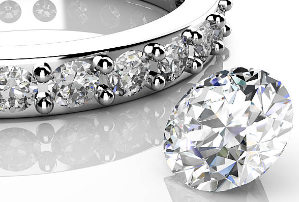
You start looking around at diamond engagement rings and wedding bands, and you quickly realize something. Your friends weddings are starting to come up, and they'll want to know what kind of ring—and more importantly, what kind of band—you want. How do you decide?Section: Why do you need a wedding band?
Choosing the right diamond is just as important as choosing the right wedding band. The diamond should complement the ring, not compete with it.
There are three main factors to consider when choosing a diamond: cut, color and clarity.
Cut: The cut refers to how the facets of a diamond reflect light. The purpose of the cut is to direct light toward the center of the stone so that it appears larger and more vibrant. The most popular cuts are round, princess, asscher, emerald, radiant and pear shapes.
Color: Diamonds come in every color imaginable from clear white to blue or yellow tinted diamonds (fancy colors). When choosing a diamond for your wedding band, you want to make sure that it blends well with its surroundings. A yellow tinted diamond might look great on its own but clash with your engagement ring if they're both yellow tinted!
Clarity: Clarity refers to the amount of internal flaws visible within a diamond when viewed through a microscope by an expert appraiser. Flaws can range from blemishes on the surface of the diamond called inclusions, which can be seen with the naked eye, to microscopic internal fractures known as fractures (very rare).
The most common diamond shapes are round, princess cut, emerald cut and oval. The round cut is the definition of a classic diamond. It has no corners and is perfectly symmetrical. The princess cut has multiple facets that make it appear to have a square shape from above, but when viewed from the side it looks like a modified round cut. The emerald cut has more depth than a traditional round cut, giving it an elongated appearance. Oval diamonds are less symmetrical than round or princess cuts because they have more surface area on one side than another.
The most important thing to consider when choosing a diamond shape is how well it will complement your engagement ring setting and wedding band. If you're wearing both together, choose one that works well with both pieces so they look cohesive as a set.
The setting of your wedding band is the part that holds the diamond in place. It's also important to consider how the diamond will look in the setting, and whether or not it will fit with your style.
Here are some common settings
Bezel Setting: A bezel setting is a metal band that surrounds the gemstone on all sides, holding it in place. It can have any number of different styles. The most common types are pronged (similar to a crown) or channel set, which has grooves for each individual stone.
Channel Setting: This style is similar to a bezel setting, except that it has grooves instead of prongs or ridges.
Pave Set: This type of setting features small diamonds evenly spaced across an entire surface area, such as the top of a ring or bracelet. This can be done using either prongs or grooves, depending on the desired look.
You've got your eyes set on a ring, but what type of metal should you choose? There are a handful of different metals that you can use in your wedding band. Here's a quick overview of the pros and cons of each:
Gold - Gold is the most popular choice for men's wedding bands because it is timeless and classic. It also has some health benefits, as it is hypoallergenic and anti-inflammatory. However, it can be expensive and difficult to repair if damaged or scratched over time.
Titanium - Titanium offers many of the same benefits as gold but at a lower cost. It's also hypoallergenic and anti-inflammatory, making it great for those with sensitive skin or allergies. Titanium rings also have a lower chance of catching on clothing or other items than gold rings do.
Steel - Steel is another durable option that has many similarities to titanium but is much cheaper than either material. Some people prefer steel over other metals because they feel that it looks better with their skin tone than either gold or titanium does. Steel also has its drawbacks though, such as being more prone to staining than other metals and having trouble with scratches over time
The most important thing is to make sure your wedding band fits properly. That way, it won't be too tight or too loose. The best way to do this is by having your fiancée wear the engagement ring while you try on wedding bands. This will ensure that they are both comfortable and fit together seamlessly. It's also a good idea to make sure that both rings are made of the same type of metal; if they're not, then they might clash with each other or look mismatched in some way.
Ultimately, your ring should reflect your personality. For example, you may want to shop for rings that are handcrafted or vintage. You might even decide to make your ring unique by mixing different styles and adding custom details that evoke your special personality. The key is to spend time searching for the perfect ring. Once you have found it, you can pair it with a matching wedding band of your own.
Sell your diamonds with ease with Diamond Registry’s comprehensive approach and vast global industry connections to help you find the best buyer for your diamond fast. Visit www.diamondregistry.com/sell-your-ring to take your first step to fast, easy and reliable way of selling your diamond.
Want to check and calculate diamond per carat instantly? Go to DR’s diamond price calculator www.diamondregistry.com/diamond-price-list/#calc-move-to to know how. Reliable and trusted carat calculator in the diamond industry since!

